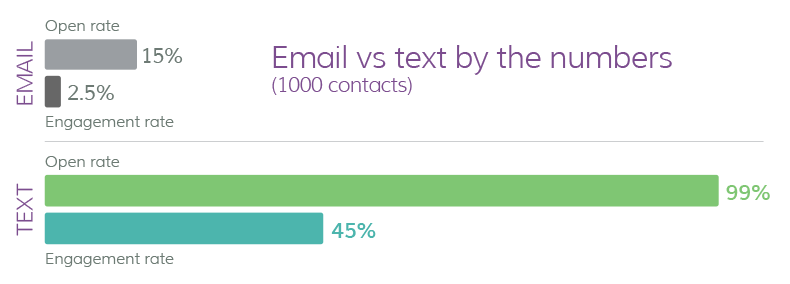SMS vs Email Marketing Engagement & Conversion Rates
In 1992, the first smartphone was launched. Fifteen years later, Apple forever changed how we communicate with the release of the iPhone. Soon, there was a smartphone in nearly every hand, pocket, or purse. This tectonic shift in technology opened the floodgates that changed marketing forever.
As people began checking their emails from anywhere at all times, emails were no longer a form of personal or professional communication that had a time and place. Email became a continuous stream of information available anytime, received at any place, enticing people to take immediate action. Converting via email marketing became the holy grail of B2C and B2B marketing.
But that was then and this is now. Email might still be the most popular way to send information, but that doesn’t mean it’s still the most effective marketing platform.
Enter, stage right: SMS marketing.
Pros & Cons of Email Marketing & SMS Campaigns
Email marketing is still alive and well – it’s just lost its spark in its old age. What was once the newest trend in reaching people where they are, is now lost in a sea of junk mail, promotions, mailing lists, and secondary email accounts set up to weed out the noise from personal inboxes.
Now, to reach people where they really are, businesses are turning to SMS marketing for better engagement and significantly higher conversion rates.
Business SMS vs Email: Delivery Rates
When it comes to delivery, settings matter. For example, iPhone users are more likely to view emails at their convenience rather than receive push notifications when emails land in their inbox(es). While Android users are more likely to have push notifications turned on, it’s typically with qualifiers — only pushing notifications from relevant email addresses.
In general, this means that consumers are not getting your marketing emails right when you send them. Instead, email marketing teams are left hoping that their subject line grabs customers’ attention as they scroll through an average of 121 emails each day.
Text messages, on the other hand, are much more frequently set to be delivered as push notifications so that they arrive immediately on the home screen. That is why a text message has a 99% read rate and is normally read within 3 minutes of receipt.
In other words, text messages allow for delivery to the right account at the right time.
Furthermore, the average person has 1.75 active email accounts (re: work emails or secondary accounts to filter marketing emails) but only one active mobile number. Meaning your chances of gaining someone’s undivided attention are via SMS.
SMS & Email Marketing Engagement Rates
So, we know that your marketing messages are being delivered. But how often they are read?
Today, a successful email campaign has a 15% open rate with a 2.5% click-through rate. Compared to the first days of email marketing, this is a significant drop in email marketing engagement.
According to current business SMS marketing stats, the average open rate for SMS campaigns is 99% with a response rate of 45%.
If you’re keeping score, that’s an 84% difference in open rate and a 42.5% uptick in engagement rate, with SMS marketing handily taking the cake.

Business SMS marketing is 19 times more effective than email marketing.
Small to Medium Business Texting Solutions
Does all this mean that text is the only way to communicate with your customers? Maybe not, but for small to medium businesses, SMS is the most cost-effective way for both B2C and B2B marketing communications. Additionally, text messaging services are an easy way to engage with leads, customers, and employees, build lists, create loyalty programs, and keep customers informed of changes or promotions.
In today’s marketing and technological climate, business texting solutions play a vital role in creating a cohesive and strategic communication strategy for any business in every market.


